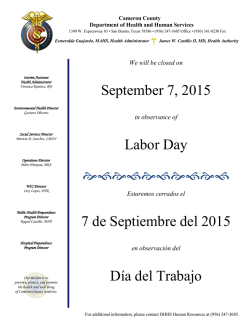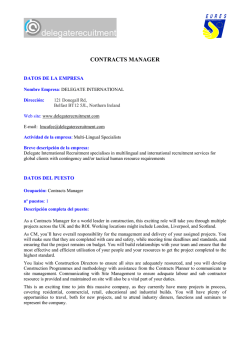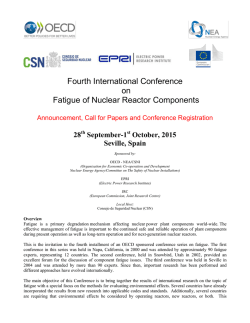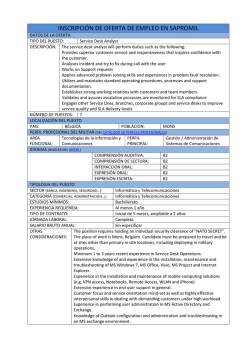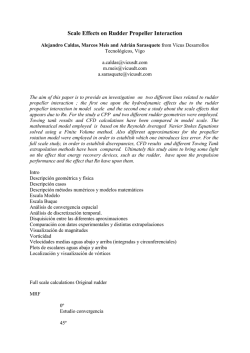
Characterizing Elastomer Fatigue Behaviour for Analysis and
Achieving a durable elastomeric component Elastomers are outstanding in their ability to repeatedly endure large deformations, and they are often applied where fatigue performance is critical. Their macromolecular structure gives rise to unique behaviors, and so appropriately specialized experimental methods are needed to characterize, analyze, and design for durability. Some factors to be included in fatigue life analysis are: Finite Strains Nonlinear Elasticity Self-Heating Strain Crystallization Characterizing Elastomer Fatigue Behaviour for Analysis and Engineering Fatigue Week, 5-9 October 2015, in Leartiker, Markina-Xemein, Spain Time Dependence Temperature Dependence Ozone Attack Mullins Effect This fatigue week organized by Leartiker and Endurica will give you powerful approaches to anticipate, diagnose and solve fatigue-related issues in elastomeric materials. Course 1: Left, Haigh diagram and mean load effects. Right, multiaxial loading on real component. About the instructor Dr. Will Mars Dr. Will Mars is an internationally acclaimed authority on the topic of damage mechanics in elastomers, and an award-winning speaker. He brings to his lectures two decades of experience developing product testing and simulation methods in the rubber industry, as well as experience teaching graduate courses as an adjunct professor at the University of Toledo. Dr. Mars has received several awards for his scientific contributions and innovations, including the 2007 Sparks-Thomas Award of ACS Rubber Division, and the 1999 Henry Fuchs Award of the SAE Fatigue Design & Evaluation committee. Dr. Mars is also the current editor of the journal Rubber Chemistry& Technology, and is a past editor of Tire Science & Technology Course format The course includes lectures, live lab demos, and hands-on exercises focused on processing and interpreting experimental measurements of fatigue behavior. Lunch, snacks, and dinner on Day 1 included. CHARACTERIZING ELASTOMER FATIGUE BEHAVIOR Duration: 3 days. When: 5, 6 and 7 October 2015 Course2: THEORY AND APPLICATION OF RUBBER FATIGUE ANALYSIS WITH ENDURICA CL Duration: 2 days. When: 8 and 9 October 2015 Course Fees: Course 1 Fee: 2250€ Course 2 Fee : 1530€ Both courses Fee: 3440€ Courses in English Contact: Leartiker Polymer R&D Lea Artibai Berrikuntza Gunea Tel.: +34 946169089 Xemein-Etorbidea 12A 48270 Markina-Xemein, Spain [email protected] Registration: Course fees are considered for 14 days prior to course start. Registration after this date will incur a late registration fee of 250 €. Cancelation policy: Leartiker reserves the right to reject registrations and to cancel a training class based on class size. A full refund will be made if a class is cancelled. If a participant cancels a registration more tan 5 days before the class then a 80% refund will be given. There is no refund for cancellations during the last 5 days before the class. N O 1M CHARACTERIZING B R E D E C A T E G O RELASTOMER ÍA Course O M B R E D E OF CATEGORÍA Course 2: THEORY ANDNAPPLICATION RUBBER FATIGUE ANALYSIS WITH Describa los elementos de esta categoría o lo que incluyen estos ENDURICA CL platos. Quizá desee especificar los primeros platos en esta catego- FATIGUE BEHAVIOR Describa los elementos de esta categoría o lo que incluyen estos platos. Puede especificar los aperitivos en esta primera categoría si el restaurante los ofrece. ría. Course Objectives Course Objectives - Know the physics and factors that govern rubber’s fatigue behavior 000 ELEMENTO - Use accurate models and efficient procedures to characterize rubber's Breve descripción del plato. fatigue behavior - Take of test strategies that minimize risk000 and maximize productivity E advantage LEMENTO - Use crack nucleation and fracture mechanics approaches effectively - Use characterization to inform accurate fatigue calculations - UseEcharacterization 000 issues L E M E N T O to diagnose and solve development - 000 ELEMENTO Know what is at stake in fatigue analysisdel plato. Breve descripción Understand principles and practices needed for accurate fatigue analysis 000 E Lmodels EMEN O Select and validate material inTEndurica Command Line Know how to set up your FE model to ensure accurate fatigue analysis Use Endurica CL to solve durability issues involving multiaxial, variable amplitude 000 ELEMENTO loading Breve descripción del plato. Breve descripción del plato. Day 1–E 5LthE of October ME N T O (Course Dinner) 1. 2. 3. 4. 5. 6. 7. 000 Breve descripción del plato. Introduction Elastomers materials 000 E L E M E NasT engineered O Design, Analysis and Characterization for Durability with Rubber Breve descripción del plato. - Stiffness, mode of control, compound optimization - Overview of the fatigue property map Stress-strain – molecular origins and hyperelasticity Stress-strain – cyclic phenomena and advanced models NOMBRE DE CATEGORÍA Self-heating in rubber Tearing Describa losenergy elementos de esta categoría o lo que incluyen estos platos. Quizá desee especificar en esta categoría las sopas y ensaladas que Day 2–ofrece. 6th of October 1. Characterizing strength of rubber 2. The fatigue threshold 3. Ozone attack 4. Strategic in fatigue testing 000 E L E M Econsiderations NTO 5. Characterizing Fatigue Breve descripción del plato. behavior of individual cracks – fully relaxing cycles 6. Characterizing behavior – nonrelaxing cycles 000 and strain E L E M E N T Fatigue O crystallization 7. Crack nucleation, S-N curves, Continuum Damage 000 ELEMENTO Day 1– 8th of October 1. 2. 3. 4. 5. E LEMENTO Characterizing crack precursor size Breve descripción del plato. Rubber’s Fatigue Design Envelope 000 000 ELEMENTO 1. Rubber product failure – what is at del stake? Breve descripción plato. 2. Overview of Endurica CL capabilities and workflows 3. Setting up the stress-strain model 000 ELEM ENTO 4. Using material modelsBreve for descripción fatigue - del fully relaxing plato. 5. Using material models for fatigue – nonrelaxing and strain crystallization 6. Industry Application :Ebushing L E M Eunder N T Oa 2-channel road load signal 000 Breve descripción del plato. th Day 2– 9 of October ELEMENTO Breve descripción del plato. 000 1. Calibrating crack precursor size 2. FEA for life prediction 3. Hands-on: sheet with a hole example NOMBRE DE CATEGORÍA 4. Dealing with Multiaxial loading in fatigue analysis 5. Hands-on: Diabolo specimen Describa los elementos de esta categoría. Quizá desee especificar en 6. Dealing with Variable loading fatigue analysis estaamplitude categoría las bebidas queinofrece. Brevethdescripción del plato. Day 3– 7 of October ELEMENTO Breve descripción del plato. 000 Multiaxial loading and Critical Plane Analysis Fatigue in tension, shear, and compression Variable amplitude loading, Rainflow counting, and damage accumulation 6. Component testing Theoretical training will be combined with live demos at Leartiker testing laboratories. ELEMENTO Breve descripción del plato. 000 ELEMENTO Breve descripción del plato. 000 ELEMENTO Breve descripción del plato. 000
© Copyright 2026
